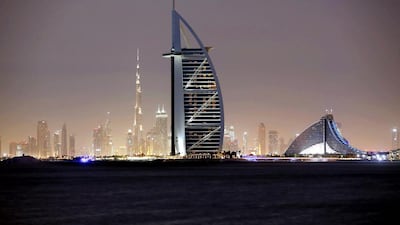The aliens may have landed once again looking for an Independence Day, but it is the sight of the world’s tallest building landing that tells another story.
If Sheikh Mohammed bin Rashid, Vice President and Ruler of Dubai, manages to see Hollywood blockbuster Independence Day: Resurgence upon its release during Eid, he could be somewhat surprised to see his emirate's most famous building hurtling nose-first out of the sky to land with bang in London, England.
It is not clear from the trailer why the Independence Day aliens – who wreaked such havoc on Earth 20 years ago and are back for more – have chosen such a means of venting their ire.
However, director Roland Emmerich, on a promotion visit to Dubai over the weekend with the film’s stars Jeff Goldblum and Liam Hemsworth, revealed that he wanted another iconic building to destroy on screen.
The sight of the uprooted and inverted Burj Khalifa crashing down like a mighty spear is symbolic of something: the stunning success of Sheikh Mohammed’s ambitious plan to transform the landscape of his city and its profile on the world stage.
When Hollywood starts lobbing your buildings all over the place, you know you have arrived.
› Find out what would it take for Burj Khalifa to be uprooted and thrown at London?
As Hollywood’s increasing fascination with the Burj Khalifa gathers pace, it is clear that it, and Dubai’s first world-famous building, the Burj Al Arab, are successfully raising Dubai’s global profile.
It was, indeed, by very good design that the striking waterside Burj Al Arab came to be one of the few globally recognisable buildings – a visual trademark for a city in the same league as the Eiffel Tower, the Sydney Opera House or the Statue of Liberty.
The commission to build the Burj Al Arab went to Atkins, then a small British engineering firm and now one of the biggest design consultancies in the Middle East.
Simon Crispe, who arrived at Atkins in 1993 as a young architect and is now a senior director, recalled that the brief given to the company had been straightforward, if immensely challenging: to build an icon for a country.
Sheikh Mohammed, who took a hands-on interest from day one, wanted nothing less than a “Sydney Opera House, a Tour Eiffel, something that would create an identifiable link for people around the world with a wonderful place, the UAE”.
With an astute awareness of the opportunities for global publicity that continues to serve Dubai well, he wanted it ready to open in time for the millennium celebrations at the end of 1999.
The daunting task fell to Tom Wright, an Atkins man who was appointed concept architect and design director for the project. He created the shape of the hotel using a piece of folded paper and a pair of scissors.
A foot-high cardboard model was made and presented in person to Sheikh Mohammed, who took one look and said: “Let’s build it.”
Dubai’s Ruler had a grand plan in his mind and instantly saw the potential of Wright’s elegant building.
His emirate’s future, Sheikh Mohammed knew, lay not in oil but in tourism.
In 2008, at the giddy height of Dubai’s rapid expansion, he summed up his philosophy of “build it and they will come”, in The Wall Street Journal.
“Our plans do not flow from mere ambition,” he wrote. “They are a necessity.
“Only 3 per cent of our revenue is from exports of diminishing crude-oil reserves. Thirty per cent is from tourism.”
Even as the hotel’s design was still being finalised, Wright later recalled “Dubai started to appear all over the place in the UK media”.
“Sheikh Mohammed started this campaign, saying, ‘Here it is, come and see,’ while at the same time he was building the Burj, which he knew – or hoped, much as we all did – would become an iconic landmark,” he said.
The building has not stood alone, of course. Malls, beaches, countless other hotels, a world-leading metro system, palm-shaped islands off the shore and countless other wonders have all served to bring the world to what less than a generation ago was little more than a small trading post clustered around the Creek.
But the Burj Al Arab was the foundation upon which Dubai’s future was built.
Work on its successor, the Burj Khalifa, began in 2004, just four years after the Burj Al Arab opened its doors to the curious of the world.
The Burj Khalifa, completed in 2010, has fulfilled its destiny as the world’s tallest and most recognisable billboard.
In 2011 Tom Cruise dangled from it in Mission Impossible: Ghost Protocol. Later this year aliens will send it streaking across the sky.
No wonder that today Dubai International Airport, which handled more than 78 million passengers in 2015, is the world’s busiest.
newsdesk@thenational.ae
This article has been amended since it was first published. It previously gave an incorrect figure for Dubai International Airport traffic for 2014.

